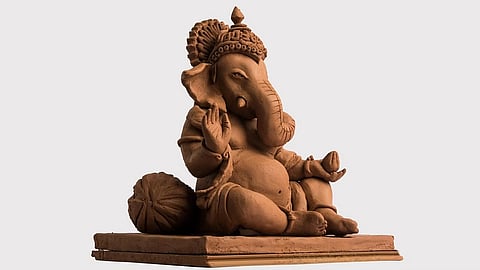

The use of eco-friendly Ganesha idols has gained attention due to growing concerns about the environmental impact of traditional idols, which are often made from non-biodegradable materials like plaster of Paris (PoP) and painted with toxic chemicals. These idols, when immersed in water during Ganesh Chaturthi, contribute to water pollution, harm aquatic life, and disrupt ecosystems.
Many communities are organizing collective water tank immersions or promoting artificial ponds to reduce the environmental impact on natural water bodies. Education and awareness campaigns are encouraging people to adopt sustainable practices during the Ganesh festival. Switching to eco-friendly Ganesha idols is a key step towards reducing the festival’s ecological footprint while still honouring cultural traditions.
Shift towards alternatives
Water Pollution: Traditional PoP idols do not dissolve easily in water, leading to water bodies becoming clogged with debris. Chemical paints contain lead, mercury, and other toxic substances that contaminate water, making it unsafe for aquatic life and human use.
Harm to Aquatic Life: The non-biodegradable materials and toxic chemicals used in idols can harm marine life, disrupting their natural habitat and food chains.
Waste Accumulation: After immersion, many non-biodegradable remnants are left behind, which contributes to long-term pollution as these materials do not decompose easily.
Soil and Air Pollution: In some cases, discarded idols are left in open spaces or burned, which can lead to air pollution and the contamination of soil.
Natural Gulaal: During the festival, use natural gulaal (coloured powder) made from plant-based or herbal sources instead of synthetic and chemical-laden gulaal. This reduces harm to both the environment and human health.
Avoid Plastic: One of the fundamental principles of celebrating an eco-friendly Ganesh Chaturthi is to minimize the use of plastic in all aspects of the festivities. Say no to plastic decorations, plates, cups, and packaging. Opt for biodegradable alternatives whenever possible.
The solution - Eco-friendly idols
Clay idols: These idols are made of natural clay that dissolves quickly in water, minimizing environmental impact.
Plantable idols: Some idols are designed to contain plant seeds. After the festival, they can be immersed in small water bodies at home or in gardens, where the idol dissolves and the seeds can be planted.
Recyclable materials: Ganesha idols made from biodegradable or recyclable are gaining popularity.
Natural paints: Eco-friendly idols use natural colors derived from turmeric, sandalwood, or vegetable dyes, which do not pollute water.
Eco-Friendly Attire: Opt for clothing made from eco-friendly materials such as organic cotton or bamboo fabric. Avoid outfits with heavy synthetic materials that have a higher environmental impact. Dressing in sustainable attire complements the eco-conscious spirit of the festival.
Ganesh Chaturthi is not just a religious festival; it is a cultural heritage that brings people together. By embracing eco-friendly practices, we can preserve this tradition while ensuring the well-being of our planet. Celebrating responsibly reflects our commitment to a sustainable future where culture and the environment coexist harmoniously. Let us unite in our efforts to make Ganesh Chaturthi a vibrant and eco-conscious celebration for generations to come.
